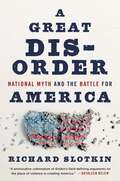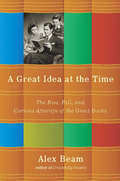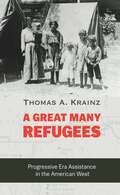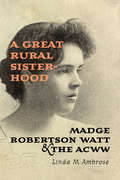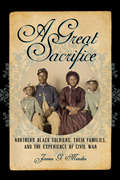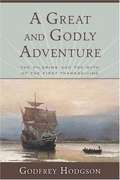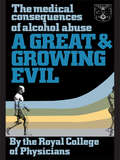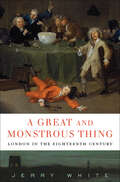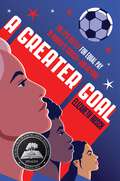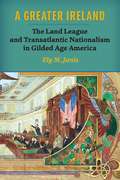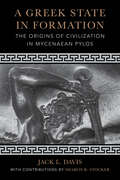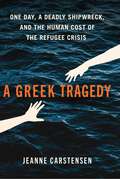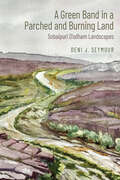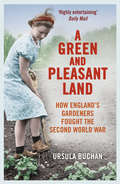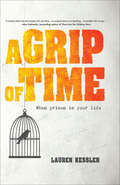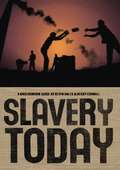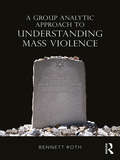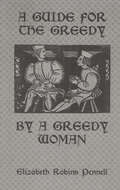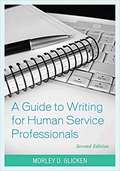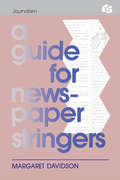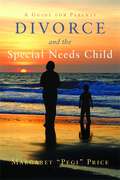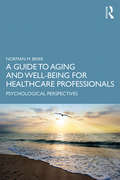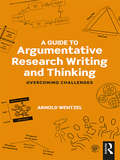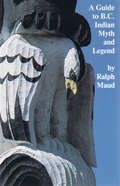- Table View
- List View
A Great Disorder: National Myth and the Battle for America
by Richard SlotkinAs culture wars pit us against each other, A Great Disorder looks to the myths that have shaped American identity and reveals how they have brought us to the brink of an existential crisis.Red America and Blue America are so divided they could be two different countries, with wildly diverging views of why government exists and who counts as American. Their ideologies are grounded in different versions of American history, endorsing irreconcilable visions of patriotism and national identity.A Great Disorder is a bold, urgent work that helps us make sense of today’s culture wars through a brilliant reconsideration of America’s foundational myths and their use in contemporary politics. Famous for his trilogy on the Myth of the Frontier, Richard Slotkin identifies five myths, born of different eras, that have shaped our conception of what it means to be American: the myths of the Frontier, the Founding, the Civil War (which he breaks into two opposing camps, Emancipation and the Lost Cause), and the Good War, embodied by the multiethnic platoon fighting for freedom. His argument is that while Trump and his MAGA followers have played up a frontier-inspired hostility to the federal government and rallied around Confederate symbols to champion a racially exclusive definition of American nationality, Blue America, taking its cue from the protest movements of the 1960s, envisions a limitlessly pluralistic country in which the federal government is the ultimate enforcer of rights and opportunities. American history—and the foundations of our democracy—have become a battleground. It is not clear at this time which vision will prevail.
A Great Idea at the Time: The Rise, Fall, and Curious Afterlife of the Great Books
by Alex BeamToday the classics of the western canon, written by the proverbial "dead white men,” are cannon fodder in the culture wars. But in the 1950s and 1960s, they were a pop culture phenomenon. The Great Books of Western Civilization, fifty-four volumes chosen by intellectuals at the University of Chicago, began as an educational movement, and evolved into a successful marketing idea. Why did a million American households buy books by Hippocrates and Nicomachus from door-to-door salesmen? And how and why did the great books fall out of fashion? In A Great Idea at the Time Alex Beam explores the Great Books mania, in an entertaining and strangely poignant portrait of American popular culture on the threshold of the television age. Populated with memorable characters, A Great Idea at the Time will leave readers asking themselves: Have I read Lucretius’s De Rerum Natura lately? If not, why not?
A Great Many Refugees: Progressive Era Assistance in the American West
by Thomas A. KrainzLocal communities in the late nineteenth and early twentieth centuries commonly addressed the needs of refugees, defined broadly during the Progressive Era to include internally displaced people and economic migrants. These communities&’ efforts to assist people in need created a type of informal pop-up welfare system of short-term assistance that provided for hundreds, and often thousands of refugees. In A Great Many Refugees Thomas A. Krainz examines how communities in the American West cared for refugees. The ten case studies include a range of different causes that forced people to flee, including revolution, war, genocide, environmental disaster, and economic recession. Communities tapped into their local resources to provide for refugees, and this informal welfare proved—in the short term—remarkably efficient, effective, and, at times, flexible and innovative. However, local communities simply could not sustain their widespread relief efforts for long and providing meaningful and comprehensive long-term aid proved a near-universal failure. Krainz&’s examination of how Progressive Era residents cared for refugees uncovers a significant segment of welfare policies and practices that have remained largely obscured. These examples of informal, short-term assistance efforts profoundly challenge our standard depiction of local Progressive Era welfare practices as anemic and unresponsive to those in crisis.
A Great Rural Sisterhood
by Linda M. AmbroseAs the founding president of the Associated Country Women of the World (ACWW), Madge Robertson Watt (1868-1948) turned imperialism on its head. During the First World War, Watt imported the "made-in-Canada" concept of Women's Institutes - voluntary associations of rural women - to the British countryside. In the interwar years, she capitalized on the success of the Institutes to help create the ACWW, a global organization of rural women. A feminist imperialist and a liberal internationalist, Watt was central to the establishment of two organizations which remain active around the world today.In A Great Rural Sisterhood, Linda M. Ambrose uses a wealth of archival materials from both sides of the Atlantic to tell the story of Watt's remarkable life, from her early years as a Toronto journalist to her retirement and memorialization after the Second World War.
A Great Sacrifice: Northern Black Soldiers, Their Families, and the Experience of Civil War (The North's Civil War)
by James G. Mendez“Offers readers new insight into the lives of African American men and women from the North in the era of the Civil War.” —Liz Regosin, Charles A. Dana Professor of History, St. Lawrence UniversityA Great Sacrifice is an in-depth analysis of the effects of the Civil War on northern black families carried out using letters from northern black women—mothers, wives, sisters, and female family friends—addressed to a number of Union military officials.Collectively, the letters give a voice to the black family members left on the northern homefront. Through their explanations and requests, readers obtain a greater apprehension of the struggles African American families faced during the war, and their conditions as the war progressed. The original letters that were received by government agencies, as well as many of the copies of the letters sent in response, are held by the National Archives in Washington, D.C.This study is unique because it examines the effects of the war specifically on northern black families. Most other studies on African Americans during the Civil War focused almost exclusively on the soldiers.“In this deeply researched and revealing book, James G. Mendez seeks to recover the experience of northern black soldiers and their families during the Civil War era in order to discover the ways they engaged the governments of their day both to recognize and respect their service and sacrifice during the war and to count the costs northern blacks paid out in impoverished families, wartime casualties, and unfulfilled promises . . . Mendez’s book deserves our attention and appreciation.” —American Historical Review
A Great and Godly Adventure: The Pilgrims and the Myth of the First Thanksgiving
by Godfrey Hodgson(back of book) An original and eye-opening history of our national origins, A Great and Godly Adventure is peppered with delightful and unexpected insights. Godfrey Hodgson sheds new light on the radicalism of the so-called Pilgrims, the financing of their trip, the state of the Indian tribes that they encountered, and the reasons they probably didn't land on the rock. The Thanksgiving traditions that Hodgson suggests are in fact not traditional at all include the idea that the first Thanksgiving was celebrated with turkey (the Pilgrims' muskets were unlikely to fire fast enough to kill one of the birds), or cranberry sauce (there was no sugar). Indeed, the settlers-who probably didn't think of themselves as Pilgrims and were certainly not revolutionaries against their king- had little to be thankful for: they were lucky not to be wiped out during their first winter.
A Great and Growing Evil?: The Medical Effects of Alcohol
by Royal College of PhysiciansFirst published in 1987. Routledge is an imprint of Taylor & Francis, an informa company.
A Great and Monstrous Thing: London in the Eighteenth Century
by Jerry WhiteThis &“magisterial history of London&” explores the rapidly changing culture and commerce of the eighteenth century in &“a book that hums with vitality&” (Times Literary Supplement, UK). London in the eighteenth century was a new city, risen from the ashes of the Great Fire of 1666. The century that followed was an era of vigorous expansion and rapid change as waves of people were drawn to its wealth, power, and many diversions. Borrowing a phrase from Daniel Defoe, Jerry White calls London &“this great and monstrous thing,&” the grandeur of its new buildings and the glitter of its high life shadowed by poverty and squalor.A Great and Monstrous Thing offers a street-level view of eighteenth century London&’s public gardens and prisons, its banks, and brothels, its workshops and warehouses. White introduces us to shopkeepers and prostitutes, men and women of fashion and genius, street-robbers and thief-takers, as they play out the astonishing drama of city life. What emerges is a picture of a society fractured by geography, politics, religion, history—and especially by class. Despite the deep and destructive gulf between rich and poor, Jerry White shows us Londoners going about their business as bankers or beggars, reveling in an enlarging world of public pleasures, indulging in crimes both great and small—amidst the tightening sinews of power and regulation, and the hesitant beginnings of London democracy.
A Greater Goal: The Epic Battle for Equal Pay in Women's Soccer-and Beyond
by Elizabeth RuschYALSA Excellence in Nonfiction Award FinalistA CCBC ChoiceMore than 250 women have played on the U.S. Women’s National Soccer Team, and most contributed to the battle for equal pay. This narrative nonfiction book by the award-winning author and journalist Elizabeth Rusch traces the evolution of that fight, bringing this important rights issue in sports and in our culture to the attention of young readers. Features extensive back matter.With the passage of Title IX in 1972, the doors opened for young women to play sports at a higher level. But for the women on the U.S. Women's National Soccer Team, being able to compete at an international level didn’t mean fair treatment and fair compensation.From economy-class airplane seats and inadequate lodging to minimal marketing and slashed wages, the women representing the United States at the Olympics, the World Cup, and other tournaments had reason to be fed up. They were expected to—and did—win, but they weren’t compensated for their talent and dedication. With the help of their union and in collaboration with the men’s team, they secured an equitable contract in 2022 that ultimately benefited both national teams as well as athletes of the future.Elizabeth Rusch’s A Greater Goal chronicles how members of the U.S. Women’s National Soccer Team fought to receive fair treatment and equal pay despite the intense pushback they received from U.S. Soccer, the governing body of soccer in the United States. With a narrative that includes player profiles and vignettes framed from team member perspectives, A Greater Goal illuminates the work, support, and grit needed to be treated with equality in a world that often undervalues the contributions of women.Features extensive back matter, including a call to action, additional resources, and an index.
A Greater Ireland
by Ely M. JanisDuring the early 1880s a continual interaction of events, ideas, and people in Ireland and the United States created a "Greater Ireland" spanning the Atlantic that profoundly impacted both Irish and American society. In A Greater Ireland: The Land League and Transatlantic Nationalism in Gilded Age America, Ely M. Janis closely examines the Irish National Land League, a transatlantic organization with strong support in Ireland and the United States. Founded in Ireland in 1879 against the backdrop of crop failure and agrarian unrest, the Land League pressured the British government to reform the Irish landholding system and allow Irish political self-rule. The League quickly spread to the United States, with hundreds of thousands of Irish Americans participating in branches in their local communities. As this "Greater Ireland" flourished, new opportunities arose for women and working-class men to contribute within Irish-American society. Exploring the complex interplay of ethnicity, class, and gender, Janis demonstrates the broad range of ideological, social, and political opinion held by Irish Americans in the 1880s. Participation in the Land League deeply influenced a generation that replaced their old county and class allegiances with a common cause, shaping the future of Irish-American nationalism.
A Greek State in Formation: The Origins of Civilization in Mycenaean Pylos (Sather Classical Lectures #75)
by Jack L. DavisA free open access ebook is available upon publication. Learn more at www.luminosoa.org. Although the Mycenaean civilization of the Greek Bronze Age was identified 150 years ago, its origins remain obscure. Jack L. Davis, codirector of excavations at the Palace of Nestor at Pylos, takes readers on a tour of the beginnings of Mycenaean civilization through a case study of this important site. In collaboration with codirector Sharon R. Stocker, Davis demonstrates that this ancient place was a major node for the exchange of ideas between the already established Minoan civilization, centered on the island of Crete, and the residents of the Greek mainland. Davis and Stocker show how adoption of Minoan culture created an ideology of power focused on a single individual, celebrating his military prowess, investing him with divine authority, and creating a figure instantly recognizable to readers of Homer and students of Greek history. A Greek State in Formation makes the powerful case that a knowledge of the Greek Bronze Age is indispensable to the classics curriculum.
A Greek Tragedy: One Day, a Deadly Shipwreck, and the Human Cost of the Refugee Crisis
by Jeanne CarstensenFive Days at Memorial meets Into the Raging Sea with this harrowing and moving true story of a devastating shipwreck during the biggest refugee crisis since World War II. On October 28, 2015, a boat meant for only a few dozen passengers capsized off the coast of the Greek island of Lesvos. Hundreds of refugees, forced in desperation onto the overloaded boat manned by armed smugglers, were tossed into a roiling sea. The resulting loss of life, the largest in a single day during the crisis in the Aegean, shocked the world. Now, after nearly a decade of research, interviews, and investigation, reporter Jeanne Carstensen has captured every detail of the dramatic twenty-four hours. This includes the recollections of the refugees&’ lives before they left their homes and a full account of the courageous rescue efforts of the Greek islanders and volunteers rushing to help, even as their government and the EU failed to act. In this remarkable narrative feat, Carstensen brilliantly showcases the extraordinary heroism of ordinary people in extreme circumstances. In a world where forced migration is on the rise, A Greek Tragedy challenges us to confront our collective humanity. It&’s an unforgettable testament of our times and a compassionate depiction of the lengths to which a person will go to save another human being.
A Green Band in a Parched and Burning Land: Sobaipuri O’odham Landscapes
by Deni J. SeymourThe result of decades of research, A Green Band in a Parched and Burning Land presents a thorough and detailed understanding of the Sobaipuri O’odham—arguably the most influential and powerful Indigenous group in southern Arizona in the terminal prehistoric and early historic periods, yet one of the least understood and under-studied to have occupied the region. Deni J. Seymour combines historical sources with fresh archaeological data and oral history to reveal an astonishingly different view of, and revise conventional wisdom around, the native history of the region. First and foremost irrigation farmers, the Sobaipuri O’odham permanently occupied verdant strips along all the major rivers in the region—including the headwaters of the San Pedro and various other areas thought to be beyond their domain. Seymour draws on career-spanning fieldwork, conversations with direct descendants (the O’odham residents of Wa:k), and recent breakthroughs in archaeological, ethnographic, and ethnohistorical research to shed light on their unique forms of landscape use, settlement patterns, and way of life. She details the building materials, linear site layout, and other elements of their singular archaeological signature; newly established dating for individual sites, complex building episodes, and occupational sequences; and evidence of cumulative village occupation as well as the habitation of river valleys and other locales long after supposed abandonment. The book also explains the key relationships between site distributions and landscape characteristics. Addressing some of the longest-standing archaeological and historical questions about the Sobaipuri O’odham, A Green Band in a Parched and Burning Land reorients the discussion of their crucial place in the history of the region in constructive new directions.
A Green and Pleasant Land: How England’s Gardeners Fought the Second World War
by Ursula BuchanSHORTLISTED FOR INSPIRATIONAL BOOK OF THE YEAR AT THE 2014 GARDEN MEDIA GUILD AWARDS. The wonderfully evocative story of how Britain’s World War Two gardeners – with great ingenuity, invincible good humour and extraordinary fortitude – dug for victory on home turf.A Green and Pleasant Land tells the intriguing and inspiring story of how Britain's wartime government encouraged and cajoled its citizens to grow their own fruit and vegetables. As the Second World War began in earnest and a whole nation listened to wireless broadcasts, dug holes for Anderson shelters, counted their coupons and made do and mended, so too were they instructed to ‘Dig for Victory’. Ordinary people, as well as gardening experts, rose to the challenge: gardens, scrubland, allotments and even public parks were soon helping to feed a nation deprived of fresh produce. As Ursula Buchan reveals, this practical contribution to the Home Front was tackled with thrifty ingenuity, grumbling humour and extraordinary fortitude. The simple act of turning over soil and tending new plants became important psychologically for a population under constant threat of bombing and even invasion. Gardening reminded people that their country and its more innocent and insular pursuits were worth fighting for. Gardening in wartime Britain was a part of the fight for freedom.
A Grip of Time: When Prison Is Your Life
by Lauren Kessler“The book provides insight into life inside a maximum-security prison while illuminating the benefits of the craft of writing. . . . compassionate.” —Publishers WeeklyA Grip of Time (prison slang for a very long sentence behind bars) takes readers into a world most know little about—a maximum-security prison—and into the minds and hearts of the men who live there. These men, who are serving out life sentences for aggravated murder, join a fledgling Lifers’ Writing Group started by award-winning author Lauren Kessler. Over the course of three years, meeting twice a month, the men reveal more and more about themselves, their pasts, and the alternating drama and tedium of their incarcerated lives. As they struggle with the weight of their guilt and wonder if they should hope for a future outside prison walls, Kessler struggles with the fiercely competing ideas of rehabilitation and punishment, forgiveness and blame that are at the heart of the American penal system. Gripping, intense, and heartfelt, A Grip of Time: When Prison Is Your Life shows what a lifetime with no hope of release looks like up-close.“Takes us on a compelling, intensely personal journey into the rarely glimpsed end point of our justice system . . . What dignity, meaning, and success these lifers achieve despite the system’s design.” —Edward Humes, Pulitzer Prize–winning author of Burned: A Story of Murder and the Crime That Wasn’t“A keenly observed and deeply felt narrative . . . so original and so compelling . . . it wouldn’t let me go.” —Alex Kotlowitz, national bestselling author of An American Summer
A Groundwork Guide: Slavery Today
by Kevin Bales Rebecca Cornell Kevin C. BalesForced to work in back-breaking, under- or unpaid jobs from agricultural work to prostitution, slaves today -- men and women, old and young -- are trapped in the same spiral of brutality and control they have endured for centuries, with one crucial difference: a collapse in the price of human beings. Globalization, governmental corruption, and the population explosion have thrust billions of people into the pool of potential slaves. This huge surplus of impoverished people has pushed the human price tag to only $100, the cost of a pair of "designer" jeans. This means that it's worse to be a slave today than ever before. "Slavery Today" traces the "products" created by this inhuman system from the jungle and farm through the global markets and into our lives and homes. It addresses the controversies over prostitution and the buying back of slaves while presenting solutions and ways readers can get involved in the growing global anti-slavery movement.
A Group Analytic Approach to Understanding Mass Violence: The Holocaust, Group Hallucinosis and False Beliefs
by Bennett RothA Group Analytic Approach to Understanding Mass Violence makes an analytic examination of the enactment of genocide by Nazi Germany during World War II to explore how mass and state-sponsored violence can arise within societies and how the false beliefs that are used to justify such actions are propagated within society. Bennett Roth makes use of Bion’s concept of ‘Hallucinosis’ to describe the formation of false group beliefs that lead to murderous violence. Drawing on both group analysis and psychoanalysis, Roth explores in relation to genocide: how people form and identify with groups the role of family groups how conflict can arise and be managed how violence can arise and be justified by false beliefs how we can best understand these dysfunctional group dynamics to avoid such violence. A Group Analytic Approach to Understanding Mass Violence will be of great interest to all psychoanalysts and group analysts seeking to understand the role of false beliefs in their patients and society more generally. It will also be of interest to students and scholars of Holocaust studies programs or anyone seeking to understand the perpetration of genocide in the past and present.
A Guerrilla Guide to Refusal
by Andrew CulpA field guide to a nonfascist life at the end of the world as we know itA Guerrilla Guide to Refusal is an unexpected approach to philosophy from a guerrilla-logic point of view. Harnessing critical theory to creatively reimagine counterinsurgency, guerrilla warfare, and interventions beyond the political mainstream, it takes us on a journey through anarchist infowar, queer outlaws, and black insurgency—through a subterranean network of communiques, military documents, contemporary art, political slogans, adversarial blogs, and captive media. In doing so, it provides powerful new insight into contemporary political movements that pose no demands, refuse labels, and offer no solutions.Written to both inspire and provoke, A Guerrilla Guide to Refusal urges us to think through the refusal to participate in politics as usual. Author Andrew Culp demonstrates how evasion can combatively deny the existing order its power. Focusing on punk cinema, anarchist pamphlets, feminist art projects, hacker manifestos, and guerrilla manuals, he foregrounds invisibility as a novel force of disruption. He draws on concepts of criminality, fugitivity, and anonymity to bring a more nuanced understanding of how power makes things—and people—visible.The book&’s unique format is that of a theoretical manual, comprising freestanding segments instead of blueprints. Poised to reach beyond the academy into activist circles, this potent theory-in-action intervention forces us to reconsider the terrain upon which our struggles against patriarchy, anti-Blackness, capitalism, and the state operate.
A Guide For The Greedy: By A Greedy Woman
by Elizabeth Robins PennellThis is surely the most extraordinary book on food and eating ever published in the English language. Miss Pennell, who was a correspondent for the Pall Mall Gazette at the height of its amusement and fashionability, was obviously the inspiration of the ‘Two Fat Ladies’. Writing about good food with good writing has never been done so successfully. Beginning with an essay on the virtue of gluttony it traverses past breakfast, sandwiches, dinner, supper, portage, soups, sole, oysters, partridge, salads and savouries, coming sadly to an all too soon a stop at cheese and coffee. Oh, but not forgetting a skirmish with the vegetables. This edition first published in 2005. Routledge is an imprint of Taylor & Francis, an informa company.
A Guide To Writing For Human Service Professionals
by Morley D. GlickenStraightforward and concise, the second edition of A Guide to Writing for Human Service Professionals offers students and professionals practical tools to improve their writing. In his animated and highly accessible teaching voice, Glicken presents the rules of punctuation, grammar, and APA style in jargon-free language that’s easy to understand. Chapters include detailed, real-world examples on how to write academic papers, client assessments and evaluations, business letters, research proposals and reports, papers for mass audiences, requests for funding, and much more. Glicken provides the most comprehensive writing guide available in an engaging and digestible format, including end-of-chapter exercises that allow readers to further practice their writing and critical thinking skills. A Guide to Writing for Human Service Professionals is an invaluable resource for current and future human service professionals across social work, psychology, and counseling.
A Guide for Newspaper Stringers (Routledge Communication Series)
by Margaret DavidsonFirst Published in 1990. Routledge is an imprint of Taylor & Francis, an informa company.
A Guide for Parents Divorce and the Special Needs Child
by Margaret Pegi" PriceGoing through a divorce is always tough, but when a child with special needs is involved it can be especially challenging. This book takes a clear and comprehensive look at every aspect of the legal divorce process, and addresses all of the legal issues that divorcing parents of children with special needs face. The author guides parents through the initial hurdles of choosing the right lawyer for their case, and explains exactly how to work with them to achieve the best possible outcome for all concerned. From agreeing upon child custody arrangements that meet the particular needs of the child, to making provision for child support payments, gathering together the documentation needed to prove a case, and dealing with financial issues such as debts and property distribution, no aspect of divorce is left uncovered. A set of checklists is included to ensure that parents consider everything they need to, and the book concludes with a useful list of further resources. Written by an experienced family lawyer who went through her own divorce when her son, who has autism, was six, this book offers much-needed guidance to divorcing parents of children with a variety of special needs.
A Guide to Aging and Well-Being for Healthcare Professionals: Psychological Perspectives
by Norman M. BrierThis book provides practical evidence-based strategies that will help clinicians across a broad range of disciplines to address and discuss the main issues an aging person is likely to face and overcome if they are to maintain a sense of well-being as they age. Based on an extensive body of research, the relevant up-to-date knowledge for each topic is concisely presented, followed by practical, concrete, evidence-based suggestions as to how a healthcare provider might acknowledge and create a partnership with their clients to help the person increase their sense of well-being. Each chapter contains a list of key terms, a summary, and case examples that illustrate in realistic and humanistic ways how a person might present the concern being addressed and intervene. The specific challenges associated with aging that are addressed include: anxiety attached to an increasing awareness of mortality; retirement; the increasing number of losses of significant others; regrets; memory loss; the arrival of old-old age and feelings of loneliness, mattering insufficiently, and a loss of purpose; and finally, dealing with imminent death. This book is suitable for all health professionals who provide clinical services or advice to older adults including physicians (i.e. particularly in the specialties of internal medicine, family medicine, geriatrics, and geriatric psychiatry), nurses, social workers, psychologists, physical therapists, occupational therapists, and audiologists.
A Guide to Argumentative Research Writing and Thinking: Overcoming Challenges
by Arnold WentzelResearch is difficult. Even though students are trained in the basic research methodology skills, when confronted with research writing, it feels to them as if they enter a bizarre world, with its own language and conventions, where it is hard to get things right. This book translates the apparent complexities of research writing into everyday ideas, language and skills, and will enable novice researchers to start overcoming the major stumbling blocks immediately. This book focuses only on the greatest challenges in research writing, specifically those that supervisors find most difficult to explain to novice researchers. These challenges include both basic and more complex skills, such as: finding original research contributions; establishing one’s voice while drawing on other authors; turning a vague idea into a feasible research question; generating literature reviews that are original in themselves; and avoiding list-like writing when discussing the research methodology. Wentzel shows that it is easier to overcome these challenges, not with lists of prescriptions that are difficult to remember while writing, but rather by cultivating an argumentative mindset. Not only is such a mindset much easier to maintain, but it offers a central point around which one can organise any difficult writing task. The book shows how to use the argumentative mindset to approach every important writing challenge. It translates all the necessary skills into jargon-free language using a variety of visuals and simple step-by-step procedures that will enable any person to read the book quickly and start writing immediately. The book is accompanied by a website containing an instructor’s manual with guidance on the teaching and assessment of research writing, as well as lecture slides.
A Guide to B.C. Indian Myth and Legend
by Ralph MaudBoas, Teit, Hill-Tout, Barbeau, Swanton, Jenness, the luminaries of field research in British Columbia, are discussed here in A Guide to B.C. Indian Myth and Legend, and their work in Indian folklore evaluated. Other scholars, amateurs and Native informants of the past and present are given ample consideration, making this book a comprehensive survey of myth collecting in B.C. The aim is to reveal the true extent of this neglected body of world literature, and to begin to sort out the more valuable texts from those damaged in transmission. A Guide to B.C. Indian Myth and Legend is a valuable reference tool for beginning or advanced students of anthropology, and an absorbing look at the research process itself.
